The Galerie Colbert and its Sounds
THE GALERIE COLBERT is one of the surviving examples of the Parisian passages couverts, the nineteenth century covered arcades built on the Right Bank of the Seine.
The passages couverts were an early form of shopping arcade that sprang up mainly in the first half of the nineteenth century. Most of them were concentrated either in the fashionable area around the Palais Royal, the Boulevard des Italiens and the Boulevard Montmartre, or around the much less fashionable, rue Saint-Denis.
Galerie Colbert
Like most of the passages couverts, the Galerie Colbert began as a speculative venture.
The story begins I suppose with Cardinal Richelieu, who in 1634 built the Palais-Cardinal, subsequently the Palais-Royal, the seventeenth century social centre of the capital. Richelieu’s palace paved the way for the development of the surrounding area including l’hôtel Bautru at the corner of the rue Petits-Champs and rue Vivienne.
L’hôtel Bautru was designed by the French classical architect, Louis le Vau, with the aide of the master mason, Michel Villedo. It was built for Guillaume Bautru, a protégé of Richelieu.
In 1665, l’hôtel Bautru became home to l’Intendant des finances et superintendant des bâtiments du Roi, Jean-Baptiste Colbert, finance minister under Louis XIV. With a change of occupant came a change of name, the building became l’hôtel Colbert.
In subsequent years, l’hôtel Colbert saw a succession of occupants; for a time it housed the stables of Philippe d’Orléans, regent of France during the minority of Louis XV, and from 1806 until 1825 it was la Caisse de la dette publique, the public debt commission.
By the early nineteenth century, passages couverts were beginning to appear in Paris. Highly ornamented and decorated covered arcades with a collection of boutiques under one roof, away from the mud of the streets and indifferent to the weather and with light pouring in through their glass roofs in the daytime and illuminated by gas lamps at night, these arcades were a new concept and they were attracting customers – lots of them.
In 1825, the Galerie Vivienne opened. It was, and still is, the doyen of the Parisian passages couverts. A company of speculators, Adam et Cie, saw an opportunity. They bought the l’Hôtel Colbert and engaged the architect, Jacques Billaud, to design and build an arcade cheek by jowl with the Galerie Vivienne.
With a nod to the last occupants of the Hôtel Colbert, the arcade was to be called le passage du Trésor but eventually the name Galerie Colbert was settled upon and it was opened in 1827.
The Galerie Colbert in 1831
The Galerie Colbert may have been competing for customers with the neighbouring Galerie Vivienne but architecturally it secured its place as an equal.
Billaud’s design included a main passage lined with boutiques surmounted by a glass roof supported by a series of triangular pediments. The polychromatic decoration included columns made from yellow marble with red marble bases and a veined grey marble frieze.
Undoubtedly, the centrepiece of the Galerie Colbert was the great rotunda, a sumptuous fifteen metre diameter glass dome.
Rotonde, Galerie Colbert
Under the dome stood a bronze candelabrum supporting a ring of seven crystal globes lit with gas. This ‘Cocotier Lumineux’, or ‘luminous coconut tree’ as it was known became the foremost destination for romantic trysts under the July Monarchy. It has since disappeared and been replaced by Charles-Françcois Leboeuf’s statue, Eurydice mourante.
Charles-François Leboeuf (1792-1865), Eurydice mourante
The 1833 edition of the Almanach du Commerce de Paris reveals that alongside the marble columns, mosaics and crystal candelabras, an eclectic collection of traders occupied the Galerie Colbert, including:
At No. 3, M. Delaroque, bookseller;
At No. 6, at the rotunda, M. Arrondelle, shoemaker and Chinese sock manufacturer;
At No. 13, Georges Legois, umbrella manufacturer;
At No. 16-18, M. Salmon, gunsmith;
At No. 23-25, the Gabriel Pleyel piano store;
At No. 28, M. Bouis, hernia truss supplier and manufacturer of belts preventing masturbation for children of all ages.
There is mention of the Colbert Pharmacy, whose flagship products included ‘stomach pills’ and ‘sarsaparilla essence’ – a cure for ‘sores, scabs, rheumatic and gouty pains, acrid blood, black humour and melancholy … and syphilis’.
Other sources report a hairdresser, tailors, seamstresses, milliners, a glove maker, a quill pen merchant, a music publisher and reading rooms with French and English newspapers. Mme. Brigitte Mathé reportedly had a bookshop with 15,000 volumes and the ‘complete collections of the principal authors’.
In the 1830s a novelty shop opened, Au Grand Colbert, later to become a famous restaurant, Le Grand Colbert, which still exists.
As a means of attracting customers, and keeping the children amused, a Géorama, an aerial trompe l’oeil, was installed at the main entrance.
When it opened, the Galerie Colbert was a success – but the success was short-lived. In 1867, the French writer and journalist, Alfred Delvau noted, “The passages Colbert and Vivienne are clean, spacious but useless because … life has withdrawn to go elsewhere on the boulevards.”
All the passages couverts faced the same problem – the tide of progress, and in the mid nineteenth century the tide was unstoppable.
The main means of mass transportation in the early nineteenth century was the stagecoach and most of the passages couverts were built close to a stagecoach terminus in order to capture potential customers waiting for or alighting from stagecoaches. The coming of the railways in the mid nineteenth century ensured the demise of both the stagecoach and the potential customers.
Progress in the form of Baron Haussmann’s redevelopment of Paris consumed some of the passages couverts but it was the mid nineteenth century seismic revolution in shopping – the birth of the department store, that signalled the end of the road for the passages couverts.
Referring to the passages couverts in his monumental Arcades Project, the German philosopher and cultural critic, Walter Benjamin quotes from the 1852 Illustrated Guide to Paris:
These arcades, a recent invention of industrial luxury, are glass-roofed, marble-panelled corridors extending through whole blocks of buildings, whose owners have joined together for such enterprises. Lining both sides of the corridors, which get their light from above, are the most elegant shops, so that the arcade is a city, a world in miniature, in which customers will find everything they need.
The mid nineteenth century department store revolution saw Aristide Boucicaut’s Au Bon Marché, Ernest Cognacq’s La Samaritaine, Jules Jaluzot and Jean-Alfred Duclos’ Printemps and Albert Kahn and Théophile Bader’s Galeries Lafayette become retail giants, taking the arcades’ world in miniature, in which customers will find everything they need and replicating it on an industrial scale.
Eugène Atget, La galerie Colbert, 1906, BnF, département des Estampes et de la photographie. Source : Gallica.bnf.fr/Bibliothèque nationale de France
Faced with all this progress the Galerie Colbert inevitably began a painful decline. Abandoned by its customers and by its traders, by 1890 it had become almost deserted. Eugène Atget’s 1906 photograph illustrates this; the lustre and even the candelabrum with its seven crystal globes has gone – the romantic trysting place is no more.
In 1916, the Commission du Vieux Paris declared that the Galerie Colbert and the neighbouring passages couverts were ‘meurent d’anémie commerciale’, dying of commercial anaemia.
It took a while but a renaissance was to come. In the 1970s there was a revival of interest in nineteenth century architecture and in 1974, the Galerie Colbert was declared a monument historique. In the early 1980s it was bought by the Bibliothèque Nationale de France who commissioned its restoration.
The gallery was in such a state of disrepair that it had to be partly demolished before any reconstruction could begin. The work was supervised by the French architect, Louis Blanchet, who ensured that the flamboyant pastiche we see today is a true representation of the original Galerie Colbert.
In 1996, the Institut National d’Histoire de l’Art moved in and between 1999 and 2004, the architects, Dominique Pinon and Pascale Kaparis, were commissioned to redesign some of areas around the historic passage and rotunda.
There are no boutiques in the Galerie Colbert today, save of course for Le Grand Colbert restaurant. Instead, the spaces once occupied by the eclectic band of traders are now meeting rooms.
As well as the Institut National d’Histoire de l’Art, the Galerie Colbert is also home to the Institut national du patrimoine and various other cultural organisations as well as providing research facilities for several Paris universities.
Sounds in the Galerie Colbert:
One hundred and fifty passages couverts were built in Paris, most of them between 1823 and 1847, but only twenty survive today. I have recorded sounds in all the surviving passages and one part of my Paris Soundscapes Archive is dedicated to their sounds.
Since we cannot listen to the sounds of these passages couverts in their hey-day, I think it important that their contemporary sounds be preserved as insurance against the day when even they may face ‘meurent d’anémie commerciale’.
Galerie Colbert: 6 rue des Petits-Champs : 2 rue Vivienne, 75002 Paris



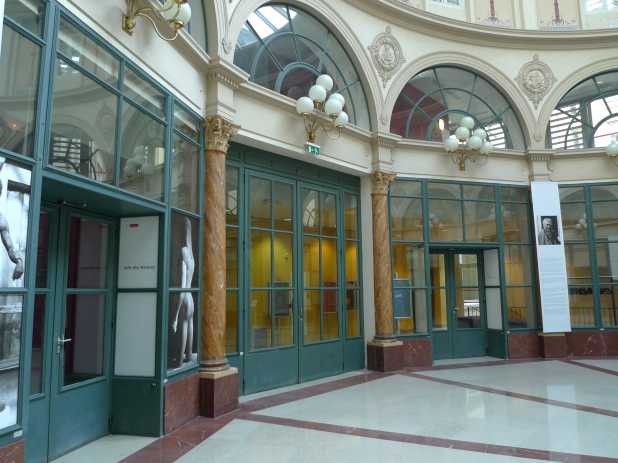
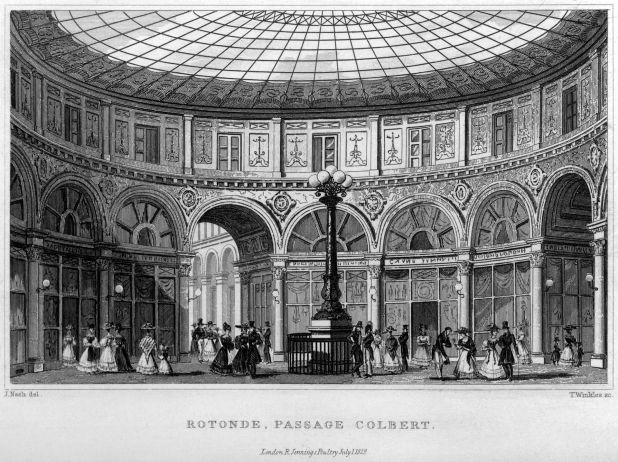
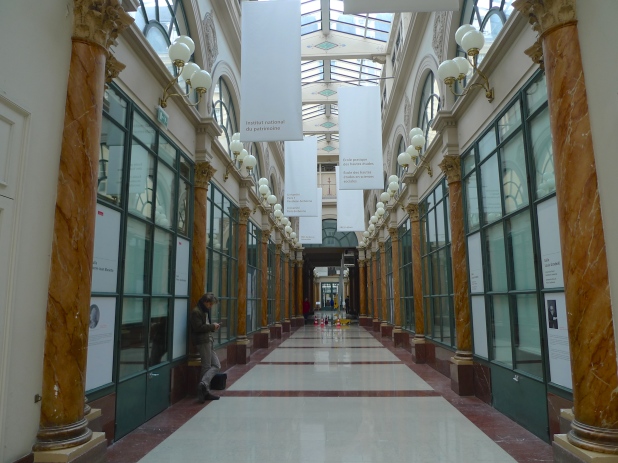
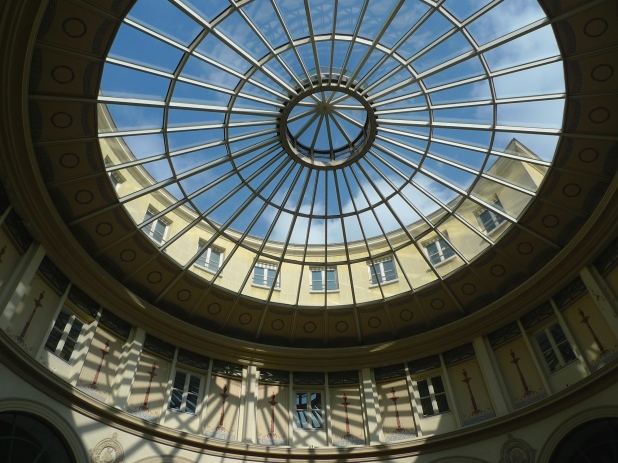
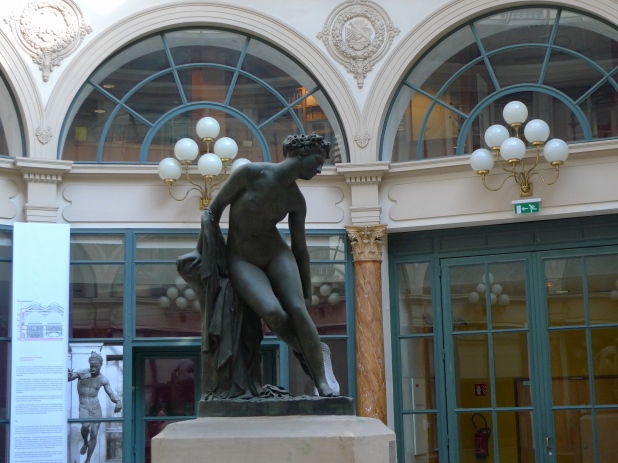
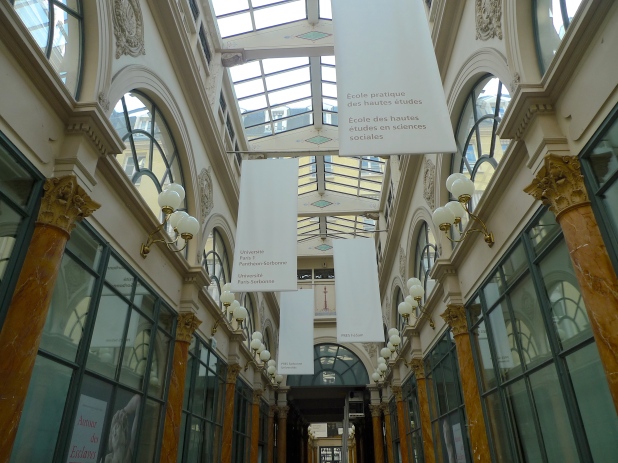
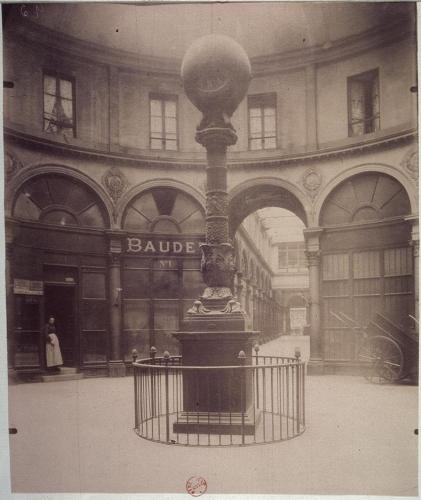
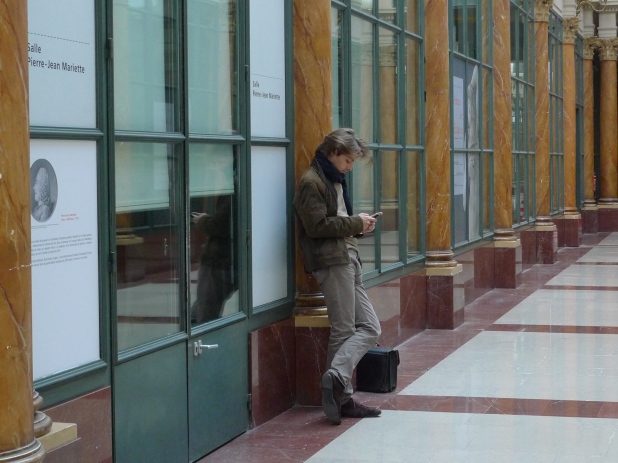
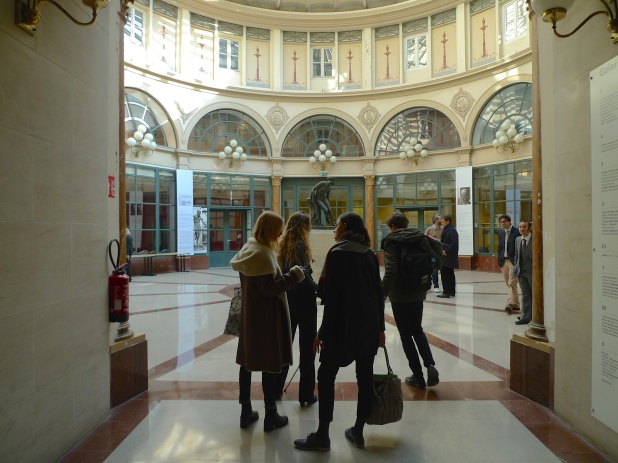





Thank you for this wonderful history lesson, Des.
If you’ll pardon the pun, your recording echoed my own experience of the place in that it seemed barren at first glance — but once I started to take photos I noticed an almost steady flow of foot traffic. It *is* interesting to consider how different it must have sounded in its heyday, isn’t it? (And I wonder if anyone back in the day erupted a loud “Hello,” like the lady halfway into your recording.)
As for the anti-masturbation belts and cures for syphilis: It would appear the Galerie Colbert’s past than its rather more colorful than its antiseptic present incarnation would suggest! 😉
Thank you, Heather.
I admit that I did have a chuckle when I happened upon the reference to M. Bouis and his wares. I am though astonished that the global pharmaceutical companies have yet to latch on to the seemingly spectacular prophylactic properties of ‘sarsaparilla essence’! Do you think we should tell them about it?
I agree, although exquisitely restored, this galerie can feel quite sterile but a little history and a lot of imagination can bring it and all its characters bounding back to life. Can you believe that in its decline the rotunda was actually turned into a garage. Now what would M. Bouis or Mme. Mathé think of that?
You raise an excellent question, Des: I’m not sure WHY the global pharma companies have not yet latched on to sarsparilla essence! Perhaps we should seize the opportunity, patent the stuff, and set up shop in the Galerie Colbert?
Thank you so much for this Des. I am researching the l’Hotel Colbert. I was wondering what happened to it. Presumably demolished but when and wondered if you knew if the hotel was open for visitors in the 1860s.
Thanks for contacting me Debbie.
The Hôtel Colbert was demolished in the late 1820s (1826 I think) to make way for the Galerie Colbert, which opened in 1828. As a ‘hôtel particulier’, a mansion, l’Hôtel Colbert was never open to the public save for those on official business. Although a great success when it opened, by the late 1860s the Galerie Colbert was on the cusp of decline and was gradually being deserted by visitors.
I hope this helps.
Thanks for that! So there were sort of two hotels. The one Marville took was obviously the one built in 1828 is that right?
Ah … I think we may have some confusion and from your mention of Charles Marville I think I understand why.
The Hôtel Colbert that was demolished to make way for the Galerie Colbert was situated at the corner of rue des Petits Champs and rue Vivienne in the 2nd arrondissement. It was demolished in the late 1820s and not replaced.
The Hôtel Colbert I think you may be referring to, the one photographed by Charles Marville, is at the corner of rue de l’Hôtel Colbert and rue de la Bûcherie in the 5th arrondissement. It was also an ‘hôtel particulier’ and as far as I know, no Colbert ever lived there.
Please forgive me if I’ve misunderstood which Hôtel Colbert you’re seeking information about but I’ll send you my email address and then perhaps we can continue the conversation. In the meantime, good luck with your research.
That would be great!